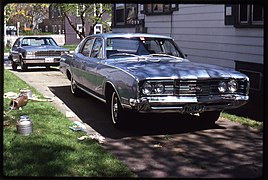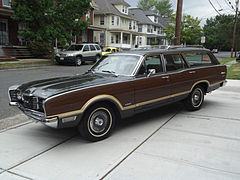Mercury Montego
| Mercury Montego | |
|---|---|
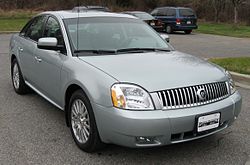 | |
| Overview | |
| Manufacturer | Mercury (Ford) |
| Production | 1968–1976 2004–2007 |
| Assembly | Atlanta, Georgia, United States Milpitas, California, United States Lorain, Ohio, United States Chicago, Illinois, United States Oakville, Ontario, Canada |
The Mercury Montego is a nameplate that was applied to three separate generations of vehicles marketed by the Mercury division of Ford Motor Company. Taking its name from Montego Bay, Jamaica, the nameplate made its first appearance for 1967 in the Canadian market as part of the Mercury-derived Meteor model line. For 1968, the Mercury Montego made its debut across North America, becoming the Mercury counterpart of the Ford Torino intermediate-size model line for two generations.
For the 1977 model year, Ford revised the intermediate-size product ranges of both its Ford and Mercury divisions; as part of a mid-cycle update, Mercury discontinued the Montego nameplate and expanded the Mercury Cougar line to include a full range of sedans and wagons (with the Ford Gran Torino becoming the Ford LTD II).
After a 28-year absence, the Mercury Montego nameplate was revived for the 2005 model year, shifting to a full-size sedan. Slotted in size between the Mercury Milan and the Mercury Grand Marquis, the 2005 Montego was the Mercury counterpart of the Ford Five Hundred. For the 2008 model year, the Montego adopted the nameplate of the car it had replaced, becoming the final generation of the Mercury Sable.
First generation (1968–1971)[edit]
For 1968, Mercury introduced the Montego as part of its intermediate Mercury Comet product line, consolidating the Comet Capri and Comet Caliente into a single nameplate; the high-performance Mercury Cyclone became a distinct model line. As the Comet was the Mercury counterpart of the Ford Fairlane, the Montego was introduced alongside the Ford Torino. For 1970, Mercury intermediates adopted the Montego nameplate entirely (as the Comet became the Mercury counterpart of the Ford Maverick).
The first-generation Montego was offered as a four-door sedan, two-door hardtop, four-door station wagon, and two-door convertible. The model line was offered in base and MX trims (replacing the Comet Capri and Comet Caliente, respectively).
For 1970, the Montego underwent a mid-cycle exterior redesign to add a forward-thrusting hood and grille design. The convertible was withdrawn, replaced by a four-door hardtop. For all sedans, a MX Brougham trim was added (with a woodgrained MX Villager station wagon), distinguished by concealed headlamps.
Second generation (1972-1976)[edit]
| 1972–1976 | |
|---|---|
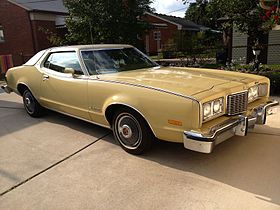 1974 Mercury Montego MX Brougham | |
| Overview | |
| Production | 1972–1976 |
| Body and chassis | |
| Class | Intermediate |
| Body style | 4-door sedan 4-door station wagon 2-door hardtop coupe 2-door fastback coupe |
| Layout | FR layout |
| Related | Ford Torino Ford Elite Mercury Cougar |
| Powertrain | |
| Engine | 250 cu in (4.1 L) I6 302 cu in (4.9 L) V8 351 cu in (5.8 L) V8 390 cu in (6.4 L) V8 400 cu in (6.6 L) V8 460 cu in (7.5 L) V8[2][1] |
| Transmission | 3-speed automatic 3-speed manual |
| Dimensions | |
| Wheelbase | 118.0 in (2,997 mm) (sedan, wagon) 114.0 in (2,896 mm) (coupe, convert.)[1] |
| Length | 223.1 in (5,667 mm) (sedan, wagon) 215.5 in (5,474 mm) (coupe, convert.) |
| Chronology | |
| Predecessor | Mercury Comet Mercury Cyclone |
| Successor | Mercury Cougar |
For 1972, the second-generation Montego was introduced alongside the Ford Torino (and all-new Ford Gran Torino).[3] In a major design shift, the intermediate Ford/Mercury model lines shifted from unibody to body-on-frame construction; in line with the General Motors A-platform, the Torino/Montego adopted a split-wheelbase chassis (114-inch for two-doors, 118-inch for four-doors and station wagons). In a preview of the full-size lines for 1973, true four-door hardtops were replaced by "pillared hardtops" (frameless door glass remained, supported by a thin B-pillar). Two-door Montegos retained hardtop rooflines, though with much wider C-pillar
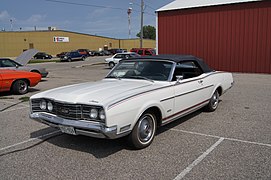
.jpg)
